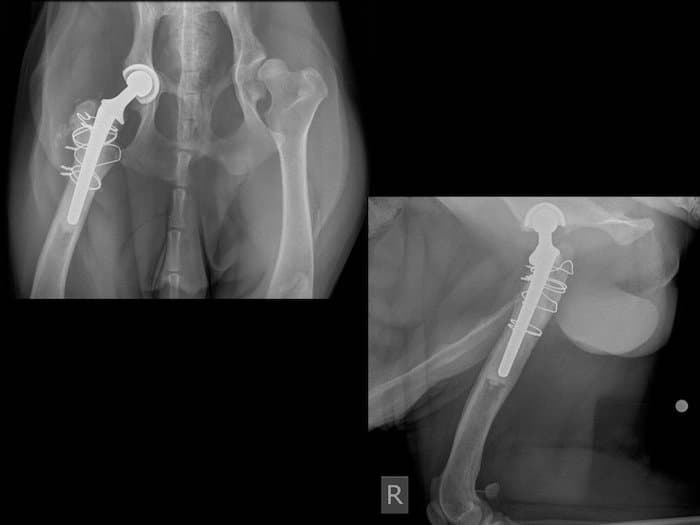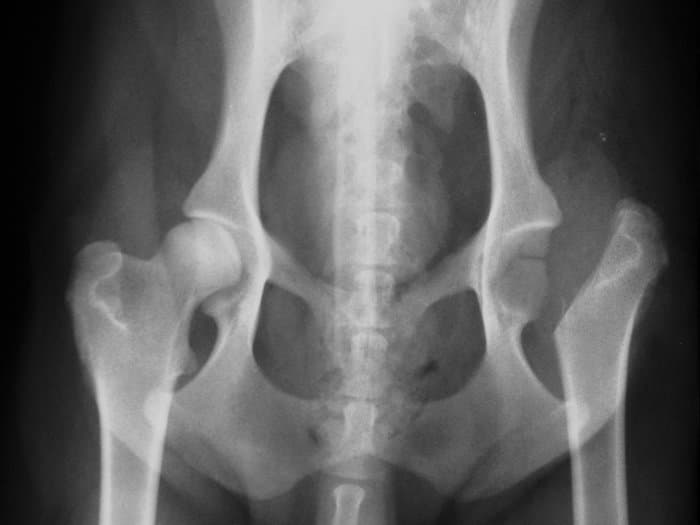How can I prevent my dog getting hip dysplasia?
Most pedigree dogs (of breeds where hip dysplasia is likely) will have their hips checked by X-ray and a hip score assigned to them. Those dogs with low scores are most desirable, as their offspring are less likely to suffer from the effects of hip dysplasia. It is probably too late to prevent hip dysplasia by the time you have got your puppy so make some investigations before you choose your puppy.
It is recommended to ban affected dogs from reproducing, simply because chances are they will transmit the condition to their offspring.
How is hip dysplasia treated?
There are numerous treatments and approaches to manage a dog with hip dysplasia. The majority of dogs affected don't require any particular treatment other than weight control, and occasional pain medication. Dogs that are more severely affected will be treated according to their age, the severity of the signs, their weight, their level of activity, the level of pain, and also the ability of pet owners to consider extensive and more costly procedures.
There are conservative medical approaches and also surgical procedures that can be considered.
If an animal is born with abnormal hips these will not get better. However, it is best to recognise the potential for hip dysplasia early in life. Management of the problem at an early stage can mean fewer difficulties in later life. In affected dogs, avoiding obesity is especially important as overweight dogs put excess strain on their bones and joints.
Animals with hip dysplasia will go on to develop arthritis in the hip joints later in life. Arthritis causes pain and stiffness but can be managed in most animals to provide a reasonable quality of life. Weight control is important and affected animals may need a restricted exercise programme. Pain relief and reduction of inflammation can be provided by medication (usually anti-inflammatory drugs).
What are the surgical procedures available?
Most of these surgical procedures are performed by orthopedic veterinary specialists in referral centers.
Juvenile Pubic Symphysiodesis (JPS)
If an early diagnosis (before 3 months of age) is made, your vet may suggest to perform a corrective procedure to modify the growth of the hip and avoid the development of arthrosis. The procedure is called 'juvenile pubic symphysiodesis'. It is performed in dogs between teh age of 12 to 20 weeks of age. It will prevent the development of hip dysplasia by fusion of the growth cartilage located at the pubic bone. This procedure is quite non-invasive triggers a rotation of the acetabulum (the cavity that is affected in hip dysplasia where the head of the femur articulates). This rotation of the acetabulum triggers a progressive coverage of the femoral head during the growth of the dog.
Animation showing the technique and the benefit of the JPS
Animation showing the difference of hip’s growth in a dog operated and a dog not operated
Triple Pelvic Osteotomy (TPO)
This surgical technique is performed in dogs between 6 and 12 months of age. It limits the development of dysplasia by correction of the femoral head coverage by the acetabulum. Candidates for such a procedure need to be carefully selected to optimize the chances of success. In such case, results are excellent.
Animation of the TPO
Total Hip Prosthesis
This surgical procedure is performed in adult dogs that are not responding to the medical treatment and are in severe pain & discomfort. The surgery consists as in people to replace the femoral head by an artificial implant. The dog will be able to walk with no more pain and regain an abnormal activity. Again selection of candidates is paramount to optimize chances of success.
Animation of the principle of hip prosthesis in a dog
Radiographs of a dog with hip prosthesis:

Femoral Head Osteotomy
This surgical procedure is usually performed in adult dogs that have severe hip dysplasia no longer responding to the medical management and that are not candidate for a total hip implant. It consists of removing the head of the femur and allow a pseudo-joint to develop. Results in terms of relief of pain are quite remarkable in dogs that are in high level of discomfort. This is a procedure that is usually recommended in small dogs as they respond much better than larger breeds.
Animation of the femoral head osteotomy procedure
Radiographs of a dog after a femoral head osteotomy:

What are the conservative & medical managements available?
Weight control
It is important to control the weight of a dog with hip dysplasia. Less weight means less stress on a painful hip and better control on the pain associated with additional pressure on an abnormal joint.
Physical therapy & Exercise
Avoid aggressive or violent exercises, jumps, or games with sudden changes in directions as these will favor inflammation of the hip joint and the development of arthrosis. Swimming and regular walks & exercise are excellent ways to maintain fitness and muscle mass and prevent any aggravation of the condition. Your dog will also enjoy it!
Physiotherapy
Physiotherapy, such as water- treadmill exercising and professional exercise therapy are often recommended. They will contribute greatly to the physical fitness and improvement in locomotion. There are today centers specialized in such physiotherapy management. Ask your vet where you should go for such treatment.
Chondroprotectors
Medications called chondroprotectors are numerous on the market. These substances have proven being beneficial in many cases. Chondro-protectant substances usually contain natural ingredients such as glucosamine, mussels extracts, chondroitine sulfate, plants, etc. that are non toxic and play a protecting role on the cartilage. Several diest aiming at the management of joint diseases are now including some of these chondroprotecting agents in their formulas.
Anti-inflammatory and anti-pain medications
Anti-inflammatory drugs decrease the inflammation associated and pain associated with arthrosis, including in hip dysplasia. Most of these drugs require a surveillance and also a prescription from your vet. Several NSAI (Non Steroidal Anti-inflammatory) medications are quite safe and a relief for dogs. They control the majority of the signs and thus manage quite well dogs suffering from hip dysplasia. Ask your vet which one of these NSAI is best for your dog.
Stem Cell Therapy
Innovating techniques using stem cells are available in certain countries and have been proven quite positive in the management of arthrosis, particularly in cases of hip dysplasia. The technique consist in taking a sample of fat from your dog (this is done via a small surgical procedure by your vet), sending it to a laboratory specialized in the preparation of stem cells from your dog's fat. The prepared solution containing your dod’s own stem cell is now injected into the joint. Results are often spectacular. Ask your vet if suh a treatment is available near you and if your dog is a good candidate for such a therapy.
If you want any other information on health issues concerning your dog please contact your vet who will be happy to advise you.
©Medi-Productions


